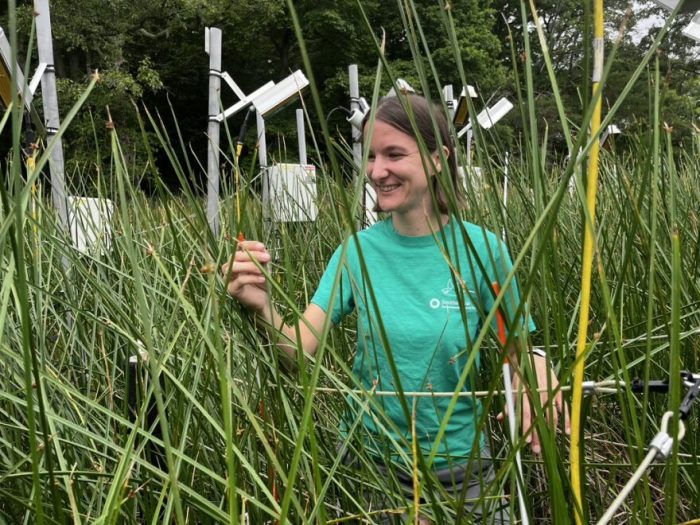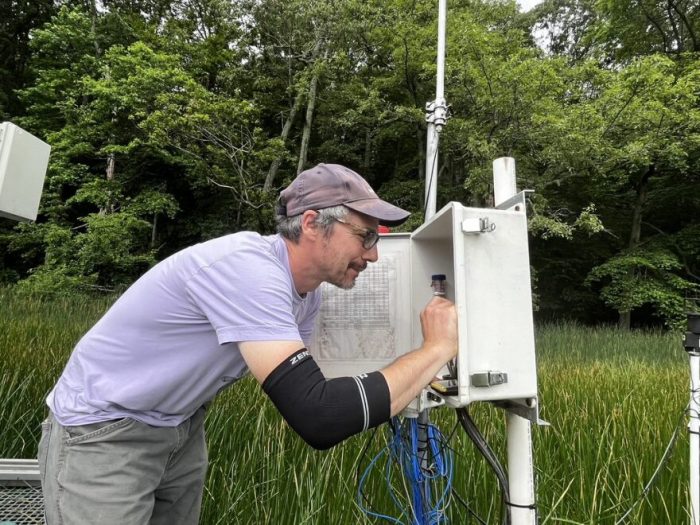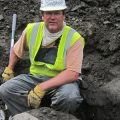Smithsonian scientists work to save Maryland’s marshes and beyond
The Chesapeake Bay’s marshes have been called the lungs of the bay. They provide habitat for fish and waterfowl. The marshes clean polluted bay waters and slow the power of floods and storms.
That’s why the scientists at the Smithsonian Environmental Research Center are studying how to preserve marshes in face of rising sea levels prompted by climate change.

At the end of a narrow winding road in southern Anne Arundel County where a vast marsh stretches on seemingly forever scientists are working on solutions. There are stands of reed grasses known as phragmites at some spots, but mostly it’s covered by bulrush and salt meadow grass.
But this is no ordinary marsh.
Instead, it’s dotted with plexiglass squares and cylinders with infrared lamps to maintain different temperatures inside each square. Pipes snake through the water, pumping carbon dioxide at different rates into each of the squares. It’s part of a carefully controlled experiment to figure out how best to preserve Chesapeake marshes.
Roy Rich, one of the scientists conducting the studies, says they are “basically constantly measuring the amount of CO2 going into those plots.”
They’re adjusting levels of carbon dioxide, a greenhouse gas, “up and down to basically create an environment within those chambers that’s at about 750 parts per million of extra CO2,” Rich said.
He says the level of carbon dioxide in the atmosphere has increased over the 35 years since these experiments began, but not quite to that level.
“We’re trying to understand how these different resources interact, and what that means for our future marshes,” he explained.

Genevieve Noyce, another scientist on the team, says healthier marsh grasses soak up more carbon dioxide, potentially easing some effects of climate change. And they provide other benefits in places like Annapolis, “where you’re getting high rates of sea level rise.”
“They’re kind of buffering storm surge,” she adds. “So you would much rather have big waves or big floods come in and kind of go through the marsh, rather than banging right up against your property.”
In Annapolis, it doesn’t take a storm to flood City Dock. At high tide on a sunny day with the wind in the right direction, water slaps against the pilings and pushes up through the storm drains and into the streets, flooding businesses and costing thousands in damage.
The city has poured millions into a system of underground pumps to keep the water out of the streets and has raised the level of the bulkheading around the dock, sharply reducing the days of nuisance flooding.
Mayor Gavin Buckley says that’s only a short-term solution. He has a $34 million project in the works to protect the dock from future flooding. But that won’t include marshes at the dock. Maybe at other places around the city’s 70 miles of shoreline, he said.
Much of the city is built out, and much of the waterfront property is in private hands.

“So we have challenges on that front, but we’re going to look at every option available to us as we prepare the city,” Buckley said.
With a few exceptions, Baltimore has similar issues as developers built up to the water’s edge. One of those exceptions is a marsh at the end of Round Road in Cherry Hill. But there are problems there as well, said Alice Volpitta of Bluewater Baltimore, because sewer pipes run under the marsh.
“And that means that these pipes are going to be more and more inundated as sea level continues to rise,” Volpitta said. “And that means that there’s less room for the sewage and the stormwater that are supposed to be flowing in pipes just like this.”
As the marsh shrinks, that means there’s less of a sponge to soak up the rain and the rising sea level.
But it’s not all doom and gloom, Volpitta added.
“Around the Middle Branch area, there’s a lot of restoration work being done to increase the amount of marsh lands to really revitalize that whole area,” she said. “And one of the most exciting parts about that project is that it’s reconnecting these neighborhoods with that waterfront resource.”
Meanwhile, the Smithsonian scientists are conducting one complicated experiment after another, hoping to understand, as Rich said, “what we need to do to keep these systems intact.”
This post by Joel McCord was originally reported and published by National Public Radio, WYPR-FM Baltimore. Listen to the original broadcast.
Posted: 13 July 2022
-
Categories:
Environmental Research Center , Feature Stories , Science and Nature








